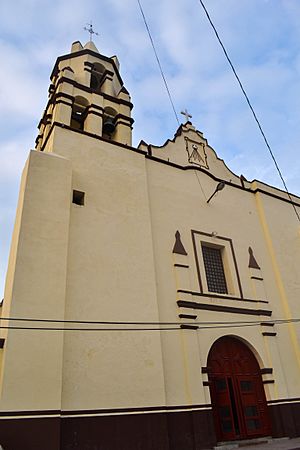Ciudad Valles facts for kids
Quick facts for kids
Ciudad Valles
|
|
|---|---|
|
City and municipality
|
|

Parroquia Santiago Apóstol
|
|
| Country | |
| State | San Luis Potosí |
| Area | |
| • Municipality | 2,424 km2 (936 sq mi) |
| • City | 36.15 km2 (13.96 sq mi) |
| Population | |
| • Municipality | 179,371 |
| • Density | 73.998/km2 (191.65/sq mi) |
| • City | 136,351 |
| • City density | 3,771.8/km2 (9,768.9/sq mi) |
| Time zone | UTC-6 (Central Standard Time) |
| • Summer (DST) | UTC-5 (Central Daylight Time) |
Ciudad Valles is a lively city in Mexico. It's the second-largest city in the Mexican state of San Luis Potosí. You can find it in the eastern part of the state (21°59′00″N 99°1′0″W / 21.98333°N 99.01667°W). This area is part of the special cultural region called Huasteca. Ciudad Valles is also the main city for the area around it, which has the same name. In 2020, about 136,351 people lived here.
Contents
Exploring Ciudad Valles: Location and Weather
Where is Ciudad Valles?
Ciudad Valles is located in the eastern part of the state of San Luis Potosí. It's a key city in the Huasteca region. This area is known for its unique culture and beautiful natural spots.
What's the Climate Like?
Get ready for warm weather! Ciudad Valles has a humid tropical climate. From April to October, it's super hot. Temperatures can reach up to 48.5°C (119.3°F) with lots of humidity. In winter, it's milder. Sometimes the temperature can drop below 10°C (50°F). The coldest it's ever been is 0°C (32°F).
Getting Around: Transportation in Ciudad Valles
The Pan-American Highway is super important for Ciudad Valles. This big road was built in the 1930s. It helps people travel easily. The highway goes north to Nuevo Laredo and south to Mexico City.
Ciudad Valles also connects San Luis Potosí with Tampico. These cities are important partners for Ciudad Valles in terms of business and government.
Adventure Awaits: Top Tourist Spots
Ciudad Valles is one of Mexico's most popular places for tourists. Especially if you love nature and adventure!
Micos Waterfall: A Series of Drops
The Micos waterfalls are famous for their steep drops. They are surrounded by green hills and lots of plants. These waterfalls are about 18 km (11 mi) from Ciudad Valles. They are part of the Tampaon River, also known as the Micos River. The river got its name because many spider monkeys used to live here.
The river flows down through many waterfalls very quickly. Rafting through the fast parts of this river is a popular activity. There's also a great viewpoint at the top of the waterfall.
Tamasopo: Waterfalls and Devil's Backbone
Another exciting place for adventure is the Verastegui Sierra. Here, you can see the amazing Espinazo del Diablo (Backbone of the Devil). It has deep canyons, some as deep as 300 m (984 ft)! Getting to this spot can be a bit tricky because the land is rough.
Close by are the Tamasopo waterfalls. This is a group of three waterfalls. They form a 20 m (66 ft) tall waterfall that crashes into a 5-meter-deep pool. There are also nice beaches along the edges of the pool.
Tamul Waterfall: The Tallest in the State
To reach the Tamul waterfall, you can take a boat from the town of Tanchachín. The boat ride takes about two hours. With a 105 m (344 ft) drop, it's the highest waterfall in the state of San Luis Potosí! It's known for its height and its clear, turquoise water.
The Tamul Falls are formed by the Gallinas River joining the Tampaon River. About 25 miles downstream from the falls, the Tampaon River flows past an ancient pyramid site called Tamtoc. Some experts believe Tamtoc is the oldest city with pyramids in northern Mexico. They even think it might be where the Aztecs started their journey to the Valley of Mexico. The best time to visit the waterfall is from July to October, when it's easy to get to.
Tancanhuitz de Santos: A Cultural Journey
This town is about 65 km (40 mi) from Ciudad Valles. It's home to the Huehuetlan Sierra creek. This creek acts as a natural border between two native groups: the huastecas and the nahuatlacos.
These two groups still keep their old languages, clothes, and traditions alive today. Every Sunday, women come down from their communities to the "tianguis" (a street market). They wear their beautiful quetzquemaletls (V-shaped ponchos) that they knit and embroider themselves. The languages spoken here are a mix of Nahuatl, Huasteco, and Spanish.
Images for kids
See also
 In Spanish: Ciudad Valles para niños
In Spanish: Ciudad Valles para niños



